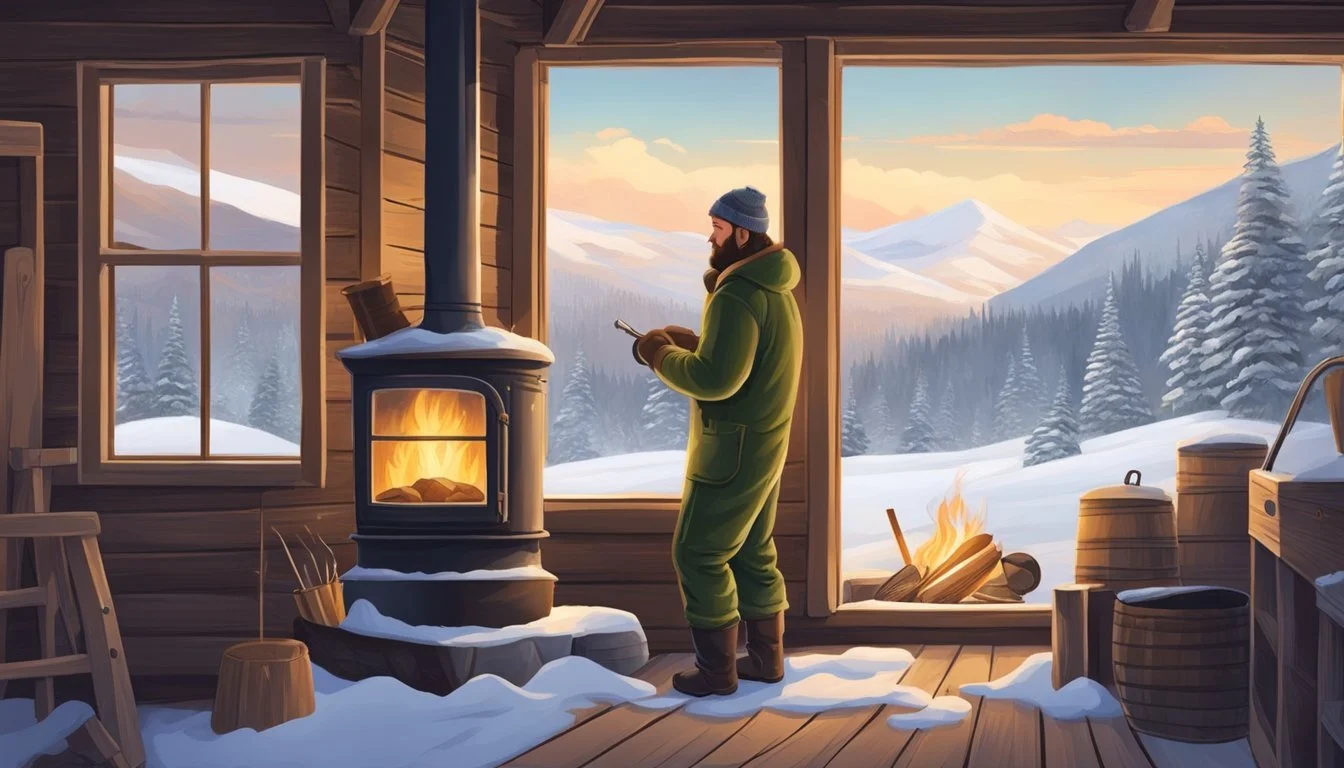Stay Warm and Cozy with Insulated Coveralls for Cold Weather Homesteading
Your Ultimate Guide
As the winter months approach and temperatures drop, homesteaders face the challenge of staying warm while carrying out their daily chores. Insulated coveralls become an essential piece of clothing for anyone braving the elements on a homestead. Designed to provide comprehensive warmth and ease of movement, these garments are meticulously crafted to keep the cold at bay, allowing for extended periods of work outdoors.
The functionality of insulated coveralls in cold weather is unmatched by traditional layering methods. These all-in-one suits offer a barrier against the frigid air, wind, and even moisture, making them a preferred choice for homesteaders who need to tend to animals, repair structures, or perform any number of outdoor tasks in cold conditions. They envelop the wearer in a cocoon of insulation that is both practical and efficient, reducing the need for bulky layers that may restrict movement.
For homesteaders, choosing the right insulated coveralls means selecting durable, water-resistant, and well-insulated options. Features such as reinforced stress points and ample pockets add to the functionality, ensuring that tools and personal items stay secure and accessible. As homesteaders spend hours outdoors, insulated coveralls are not just a convenience; they are a necessity for well-being and efficiency in the pursuit of a self-sufficient life amidst chilly climes.
Understanding Insulation for Cold Weather
Effective insulation is critical for maintaining body heat and comfort during the winter months. This section will dissect the concept of insulation and the materials commonly used to achieve warmth in frigid temperatures.
The Science of Insulation
Insulation works by trapping heat that the body generates, forming a warm barrier between the wearer and the cold environment. Three principal methods of heat transfer—conduction, convection, and radiation—are mitigated through proper insulation, particularly in winter attire. Insulated coveralls, an essential for cold weather, utilize this science to keep individuals warm during their outdoor activities.
Key points to remember:
Conduction: Reduction of heat loss through direct contact.
Convection: Minimization of heat loss due to the movement of air or liquid around the body.
Radiation: Limitation of heat escaping from the body's surface.
Insulation Materials
Insulation materials in winter coveralls vary, but the goal remains consistent: to hold body heat and prevent cold air from penetrating. Two prominent insulation materials are:
Down: Known for its exceptional warmth-to-weight ratio, down is the fine layer of feathers found under the tougher exterior feathers of birds. It is prized for its efficiency in trapping warmth, although it performs poorly when wet unless treated for water resistance.
Synthetic Fibers: Polyester and fleece are popular synthetic options that retain insulation capability even when damp. They are generally more cost-effective and easier to clean than down, making them suitable for rugged, everyday use.
Layers in Coveralls:
Outer layer: Typically water-resistant or waterproof to protect from the elements.
Insulation layer: Often down or synthetic fibers providing the actual insulation.
Inner layer: Can be a soft, moisture-wicking material for added comfort.
In summary, understanding the science behind insulation and the materials used can lead to better choices when selecting insulated coveralls for homesteading in cold weather.
The Essentials of Winter Homesteading Gear
When temperatures plummet, staying warm and protected is crucial for anyone living on a homestead. The right gear is not only about comfort but also about safety and efficiency during winter tasks. Carefully selected apparel can make a significant difference.
Headwear Choices
One must consider the head as a critical heat-loss point that requires adequate insulation. A wool hat or beanie is vital in retaining heat and should be a staple in the homesteader's winter wardrobe. Look for hats that are both moisture-wicking and insulating to maintain warmth even when active. In extreme conditions, a hat with ear flaps provides additional protection against the cold wind.
Choosing the Right Footwear
Footwear is paramount for winter homesteading; select boots that are not only warm but also waterproof and durable. Insulated boots with thick, non-slip soles afford stability and warmth when trekking through snow or icy terrain. It is essential to pair these boots with wool socks, which offer excellent insulation and moisture control, keeping feet dry and comfortable.
Layering for Optimal Warmth
Effective layering is the cornerstone of winter warmth:
Base Layer: Begin with a moisture-wicking base layer to keep skin dry. Synthetic fabrics or merino wool are ideal for wicking away sweat while providing insulation.
Mid Layer: Add a fleece or vest for an additional layer of warmth. The vest's armless design allows for mobility while trapping heat at the core.
Outer Layer: Top with a windproof, water-resistant outer layer. Insulated coveralls or a heavy jacket will shield against the elements.
Switching between activities may require adjustments in layering, so ensure each piece is easily removable and breathable.
For extremities, mittens are often warmer than gloves and should be water-resistant. To protect the neck, a scarf or neck gaiter made from a warm, non-itchy fabric will provide insulation without irritation.
Selecting Insulated Coveralls
When choosing insulated coveralls for cold weather homesteading, it's essential to focus on specific features that ensure warmth and durability. These attributes are critical for comfortable and long-lasting wear during outdoor work in chilly climates.
Features of High-Quality Coveralls
High-quality insulated coveralls have several features tailored for performance in cold environments:
Insulation: Look for coveralls with sufficient padding, such as Thinsulate, to trap and retain body heat effectively.
Water-Resistance: A water-resistant outer layer is crucial for protection against snow and rain.
Zippers: Durable zippers help in retaining warmth, and those with large pulls are easier to handle with gloves on.
Leg Zippers and Snaps: Zippers or snaps that run along the legs make it simple to put on the coveralls over boots or other layers.
Pockets and Loops: Ample storage, like deep pockets and specific loops such as a hammer loop, adds practicality for carrying tools.
Reinforced Knees: Areas prone to wear, such as the knees, should be reinforced, ideally with provisions to insert knee pads.
Material and Build Considerations
The material and construction of insulated coveralls impact both their efficiency and longevity:
Outer Shell: A robust outer shell, often made of materials like cotton duck or ripstop, stands up against tear and abrasion.
Inner Lining: A soft inner lining increases warmth and comfort, especially when layered over leggings or tights.
Stitching: Quality stitching prevents insulation from shifting and maintains the coverall's shape over time.
Fit: They should allow for ease of movement without being too loose, which could let in cold air, or too tight, restricting layers underneath.
Practical Tips for Staying Warm Outdoors
When venturing into the outdoors during winter days, staying comfortable and warm is essential. The following subsections provide specific, actionable strategies for homesteaders to stay insulated against the cold using coveralls and other techniques.
Effective Layering Strategies
The foundation of staying warm begins with effective layering. One should start with a moisture-wicking base layer to keep the skin dry. Mid-layers should be insulating, such as a fleece or wool, which trap heat. The final layer, or outerwear, must be both water-resistant and windproof. For optimal warmth, homesteaders should consider insulated coveralls as their outermost layer, as they offer integrated protection with less bulk.
Base layer: Lightweight and moisture-wicking (e.g., synthetic fabrics or merino wool)
Mid-layer: Insulation that retains heat (fleece, down, or synthetic insulation)
Outerwear: Water-resistant and windproof protective layer (insulated coveralls)
Dealing with Wet Conditions
Wet conditions sap warmth more rapidly than cold alone. It is vital to remain dry with water-resistant materials. Seek coveralls with a water-repellent finish and use water-resistant boots. Keep additional clothing on hand to change into if one gets wet.
Outer layers: Choose materials with a durable water repellent (DWR) coating.
Footwear: Select boots that are insulated and waterproof to prevent moisture from seeping in.
Protect extremities: Wear water-resistant gloves, hats, and use hand warmers to maintain warmth in the body's extremities.
Maximizing Body Heat Retention
Insulated coveralls can be a game-changer for retaining body heat but must be accompanied by smart tactics. Homesteaders should utilize hand warmers inside gloves or pockets for extra warmth. Additionally, keeping the head and neck covered with insulated hats and scarves can prevent significant heat loss.
Insulated accessories: Hats and scarves provide additional insulation.
Hand warmers: Small, air-activated packets that offer concentrated warmth; place them in gloves or pockets.
Movement: Stay active to generate body heat, but be mindful not to sweat as this can lead to cooling.
Through these targeted approaches, one can enjoy the winter outdoors while maintaining comfort and warmth.
Homestead Winter Preparedness
Winter poses unique challenges for homesteaders, making preparedness essential for food security, animal welfare, and infrastructure integrity.
Food Storage and Canning
Homesteaders ensure a continuous food supply during winter by preserving the summer's bounty. Efficient canning practices are critical, utilizing methods like water bath and pressure canning to store fruits, vegetables, and meats. A diverse pantry, filled with jars of pickles, tomato sauces, and fruit preserves, provides nutritional variety and self-sufficiency.
Inventory Checklist:
Jars of vegetables and fruits
Canned meats and broths
Pickles and relishes
Jams, jellies, and marmalades
Maintaining Warmth for Animals
Animal welfare is paramount in the cold months. Homesteaders must prepare suitable animal shelters that provide insulation from the cold. Adding straw bedding and ensuring that the shelters are free of drafts help maintain body heat. Regular checks for signs of distress or cold exposure are vital.
Shelter Essentials:
Straw or hay bedding
Wind-blocking materials
Insulated water troughs
Adequate space for movement
Protecting Water Pipes
Frozen pipes can cause significant damage and disrupt a homestead’s water supply. Insulating pipes with foam or fiberglass sleeves helps prevent freezing. It's important for homesteaders to know where the main water shut-off is located and have a plan for thawing pipes safely if they do freeze.
Pipe Maintenance:
Insulate with sleeves
Periodically run water to prevent freezing
Locate and label the main shut-off valve
Keep pipe-thawing tools accessible
Winter Workwear Maintenance
Maintaining winter workwear is crucial for longevity and performance. Insulated overalls, such as those offered by Carhartt and Dickies, require particular care to ensure they retain their thermal properties and durable construction.
Cleaning and Storage
Cleaning:
Insulated Overalls: When cleaning insulated overalls, it's essential to follow the manufacturer's instructions carefully. Use a mild detergent and cold water for washing. Carhartt and Dickies often recommend a gentle cycle for their winter coveralls.
Abrasion-Resistant Areas: Pay special attention to abrasion-resistant parts, like double knee sections. Ensure to remove any debris before laundering to avoid damaging the fabric or washing machine.
Storage:
Store insulated coveralls in a cool, dry place away from direct sunlight.
Hang coveralls using wide hangers to keep the shape and to avoid compression of the polyester insulation.
Note: Avoid storing in plastic bags or containers, which can trap moisture and lead to mildew.
Repairing Your Gear
Examine Regularly: Regularly check areas prone to wear, especially those with abrasion-resistant material like denier nylon.
Minor Repairs: For small tears or holes, use a patch made from a similar material. Iron-on patches work well for quick fixes.
Professional Repairs: For significant damage or if the integrity of the insulation is compromised, seek professional repair services. Good quality workwear like Carhartt and Dickies can often withstand professional repairs without compromising functionality.
Maintaining these practices will extend the life of winter workwear and ensure it provides consistent warmth and protection through the homesteading winter months.
Brands and Products Overview
When searching for insulated coveralls for homesteading in cold weather, durability and warmth are paramount. Two notable brands that stand out are Walls and Dickies, each offering products designed to withstand harsh conditions while providing comfort and ease of movement.
Walls Men’s Zero-Zone
The Walls Men’s Zero-Zone Twill Insulated Coverall serves as a robust choice for outdoor gear. It features a thick insulation layer vital for sub-zero environments typically encountered during winter homesteading chores. The coverall's shell material is water-repellent, ensuring the wearer stays dry, which is critical in maintaining warmth in cold, wet conditions.
Dickies Men’s Sanded Duck
On the other hand, the Dickies Men’s Sanded Duck Insulated Coverall is tailored for those who prefer a balance between mobility and warmth. This garment employs a sanded duck fabric, offering a softer feel without sacrificing the toughness needed for outdoor labor. The insulation is tailored to provide warmth without excessive bulk, allowing freer movement which is essential when performing various tasks on the homestead.
Both brands take into account the necessity for easy donning and removing of coveralls, integrating features like zippered legs that accommodate boots. While not explicitly mentioned, other industry experts may also recommend options like Refrigiwear for those seeking specialized cold weather gear. With these products, individuals can confidently tackle the cold while engaged in homesteading activities.
Accessorizing for Winter Work
When working outdoors during winter, the right accessories are not just about comfort, they're about safety. From headgear that retains heat to gloves that offer dexterity and warmth, selecting the appropriate items can make all the difference in harsh conditions.
Headgear and Hand Protection
A well-insulated beanie or other forms of winter hats are fundamental for minimizing heat loss through the head. Working outdoors requires gear that can withstand tough conditions, so it's advisable to choose materials such as thick, tightly-woven wool or high-performance synthetics.
For hand protection, winter gloves made with synthetic materials are essential. They should offer a balance between insulation and functionality to maintain dexterity. Moreover, features such as water resistance and good grip are key for managing tools and ensuring safety. Consider options like:
Gloves with synthetic insulation: Offer excellent warmth-to-weight ratio.
Shearling-lined gloves: Great for their natural insulation properties.
Thermal Accessories
In addition to headgear and gloves, other thermal accessories play a crucial role in a worker's winter arsenal. Bibs and overalls lined with an insulated material provide another layer of warmth and can be easily integrated with existing workwear. Crafting a layering system that includes these items helps retain core heat.
Essential oil diffuser: While not a typical outdoor accessory, workers can benefit from an essential oil diffuser inside their vehicles or homestead to create a warm, calming atmosphere after work.
Regarding footwear, it's important to consider not only insulation but traction. Boots with a reinforced grip can prevent slips and falls on icy surfaces. Employing a combination of deep lugs and durable materials will help maintain stability and safety when traversing treacherous winter terrain.







